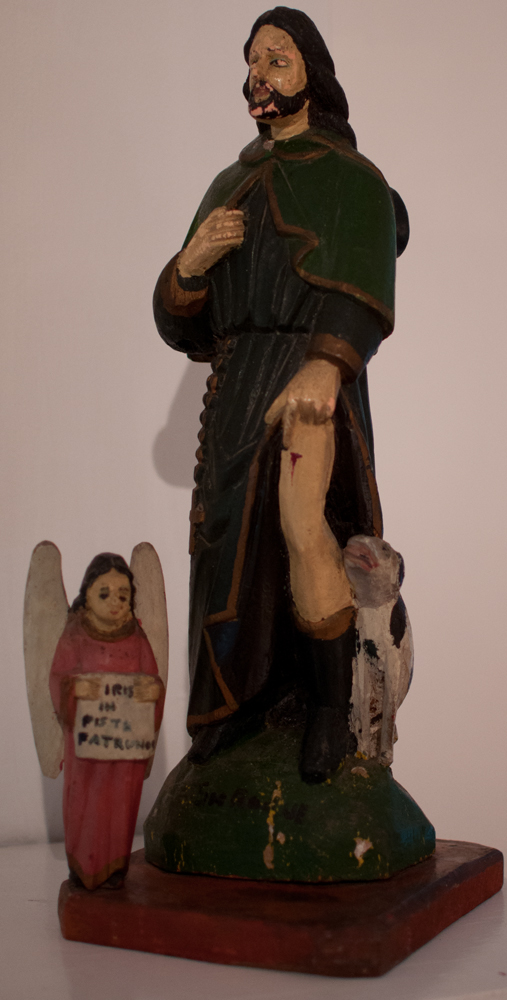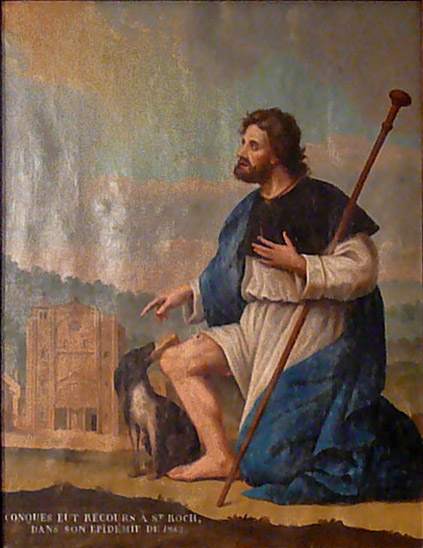These identifiers relate to a key period in the saint's life. In his youth he had distributed his inheritance to the poor (image) and left his home in Montpellier to go on various pilgrimages, where he discovered that he could cure people of the plague simply by touching and blessing them with the sign of the cross. But eventually he contracted the plague himself while working in the hospital in Piacenza (image).1 To avoid infecting others he took to the forest, where he made himself a shelter from leaves and boughs and prayed for help in his distress (image). (In Diedo's Vita the prayer seems intended as a model for readers to imitate in their own distress.2) Even while lying sick, he is able to cure animals and people who come to his hermitage (image).
In answering Roch's prayer God first caused a spring of water to open up beside the shelter (image). Second, a dog came regularly to bring him bread from its master's table. This is the dog seen in so many portraits. Finally, after several years an angel appeared and told Roch his illness was to be cured and he was to return to his home in Montpellier and there complete his earthly journey. In some images the angel addresses Roch while pointing to Heaven (example), in others he has arrived with a small jar of medicine, as in the picture above right, and in still others he kneels down to treat the lesion directly (example).
Obeying the angel's command, Roch returned to Montpellier, but he was mistaken for a spy and cast into prison (image), where five years later he died and his soul was gloriously taken into Heaven (image). An angel left a tablet under the head announcing in golden letters that "who that calleth meekly to St. Rocke he shall not be hurt with any hurt of pestilence." A shortened version of this message appears in some images, such as the second one shown on the right.
In many images Roch is paired with St. Sebastian (example). Paul the Deacon's History of the Lombards credited the intercession of that saint for the end of a plague in Pavia in the 7th century.
Prepared in 2015 by Richard Stracke, Emeritus Professor of English, Augusta University
HOME PAGE

A santo in Furelos, Spain (See description page)

Roch, the dog, and the angel with the tablet (See description page)

A memorial to the saint's help to a village in France during a plague (See description page)
ATTRIBUTES
- Wound or bubo on thigh
- Dog with bread loaf in mouth
- Small angel at side
- Pilgrim's garb and staff
MORE IMAGES
- 15th century: With Saints Maurice and Nicholas on Strasbourg Cathedral's St. Maurice altarpiece.
- 1500: In Giovanni Buonconsiglio's classicizing St. Sebastian with St. Roch and St. Lawrence Roch points to his bubo but the angel, dog, and loaf are all excluded.
- 1504: This Madonna and Child is flanked by the two plague saints, Sebastian and Roch.
- 1510: A stained glass panel from Trier.
- 1588: Tintoretto's Vision of St. Roch.
- Late 16th century (estimate): Madonna and Child with SS. Sebastian, Roch, and Monica.
- Circa 1600: Altarpiece of Our Lady of Mercy, flanked by SS. Sebastian and Roch.
- 17th century: Giovanni Maria Morlaiter's relief, St. Roch Curing the Plague Victims on the façade of the Church of San Rocco in Venice.
- 18th century: Angeli's portrait of St. Roch contemplating a vision.
- Undated, possibly 19th century: Statue of Roch in clerical garb on an island near Venice.
- Undated: Statue in South Tyrol, paired with a statue of St. Sebastian.
- Undated: Three Plague Saints in a painting the Scalzi Church, Venice.
DATES
- Farmer estimates St. Roch's dates as 1350-1380. Butler has his death date as 1378.
- Neither of the sources in the Acta Sanctorum gives a date for Roch's death, but Caxton specifies August 16, which is his feast day.
NAMES
- Some English sources spell his name "Rock."
- In Italian he is San Rocco.
BIOGRAPHY
- William Caxton's The Life of St. Rocke is loosely translated from the second of the two vitae in the Acta Sanctorum, August vol. 3, 380-415. For a comparison of Caxton's work with the original, see Sister Mary Jeremy, "Caxton's Life of S. Rocke."
- Also see the Mass lessons for St. Roch's feast day in Analecta Bollandiana, VIII (1889), 195-96.
NOTES
1 It seems clear that this was specifically the bubonic plague. In Caxton it attacks the saint first in his armpits. In the Latin vitae, it arrives as a fever followed by a knife-like pain in his "hip" (coxa), a detail that the artists consistently take to mean his upper thigh. Both fever and swellings in the armpits and groin mark the onset of this disease.
2 Acta Sanctorum August vol. 3, 403.